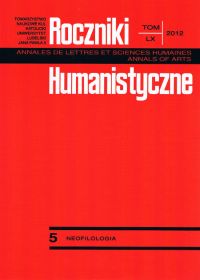Predicational, Specificational, Equative and Identificational Copular Clauses in English and Polish
Abstrakt
Zdania kopularne predykatywne, specyfiujące, utożsamiające i identyfikujące w języku angielskim i polskim
Artykuł konfrontuje typologię zdań kopularnych, zaproponowaną przez Higginsa (1979) dla języka angielskiego, z danymi z języka polskiego. Higgins wyróżnia w angielszczyźnie cztery typy zdań kopularnych, tj. predykatywne, specyfikujące, utożsamiające i identyfikujące. W artykule pokazano, że te cztery typy zdań obecne są także w polszczyźnie, choć ich inwentarz jest znacznie większy niż w języku angielskim, ponieważ polszczyzna posiada, poza kopulą werbalną, również kopulę zaimkową to, a także wykazuje obecność dwóch tych elementów w jednym zdaniu (tzw. zdania o dwóch kopulach). Wszystkie te trzy typy zdań kopularnych mogą występować w funkcji predykatywnej, pozostałe zaś trzy funkcje mogą być realizowane wyłącznie poprzez zdania z to lub zarówno z to, jak i z być. Przedstawione są przykłady zdań wieloznacznych oraz przywołane są testy umożliwiające eliminację tych dwuznaczności. Ponadto, podjęta została próba redukcji typologii Higginsa. Wykazano, że zdania utożsamiające o odwróconej kolejności składników w języku polskim wykazują cechy typowe dla zdań specyfikujących. Jeśli zaś idzie o zdania identyfikujące, to przedstawiono argumenty za tym, że zarówno w angielszczyźnie, jak i w polszczyźnie można je zakwalifikować albo jako zdania specyfikujące, albo utożsamiające.
Bibliografia
Adger, D. and G. Ramchand. 2003. Predication and equation. Linguistic Inquiry 34(3): 325-359.
Akmajian, A. 1979. Aspects of the grammar of focus in English. New York: Garland.
Błaszczak, J. and L. Geist. 2000a. Zur Rolle des Pronomens to/ėto in spezifizierenden Kopulakontruktionen im Polnischen und Russischen. In G. Zybatow, U. Junghanns, U. Mehlhorn, and L. Szucsich (eds.) Current Issues in Formal Slavic Linguistics (Linguistik Intenational 5). 247-257. Frankfurt am Main: Peter Lang.
Błaszczak, J. and L. Geist. 2000b. Kopulasätze mit den pronominalen Elementen to/ėto im Polnischen und Russischen. In E. Lang (ed.) Copular and AUX – Constructions. ZAS Papers in Linguistics 16: 115-139. Berlin: ZAS.
Citko, B. 2008. Small clauses reconsidered: Not so small and not all alike. Lingua 118: 261-295.
Declerck, R. 1988. Studies on copular sentences, clefts and pseudoclefts. Dordrecht: Leuven University Press and Foris.
den Dikken, M. 2006. Relators as linkers The syntax of predication, predicate inversion and copulas. (Linguistic Inquiry Monographs). Cambridge, Mass.: MIT Press.
Heycock, C. and A. Kroch. 1999. Pseudocleft connectedness: Implications for the LF interface level. Linguistic Inquiry 30(3): 365-397.
Higgins, R.F. 1979. The pseudo-cleft construction in English. New York: Garland.
Mikkelsen, L. 2005. Copular clauses. Specification, predication and equation. Amsterdam and Philadephia: John Benjamins.
Mikkelsen, L. 2006. Specificational copular sentences. Paper presented in Kobe Area Circle of Linguistics, Kobe Shoin Women’s University, November 2006.
Mikkelsen, L. 2011. Copular clauses. In K. von Heusinger, C. Meienborn and P. Portner (eds.) Semantics: An International Handbook of Natural Language Meaning. Berlin: Mouton de Gruyter.
Moro, A. 1997. The raising of predicates: Predicative noun phrases and the theory of clause structure. Cambridge: Cambridge University Press.
Partee, B. 1998. Copula inversion puzzles in English and Russian. In K. Dziwirek, H. Coats and C. Vakareliyska (eds.) Formal Approaches to Slavic Linguistics: The Seattle Meeting 1998. 361-395. Ann Arbor: Michigan Slavic Publications.
Partee, B. 2010. Specificational copular sentences in Russian and English. In A. Grønn and J. Marijanovic (eds.) Russian in Contrast, Oslo Studies in Language 2(1): 25-49.
Pereltsvaig, A. 2001. On the nature of intra-clausal relations. Doctoral dissertation, Montreal, McGill University.
Rothstein, S. 2001. Predicates and their subjects. Dordrecht: Kluwer.
Williams, E. 1983. Semantic vs. syntactic categories. Linguistics and Philosophy 6(3): 423-446.
Copyright (c) 2012 Roczniki Humanistyczne

Utwór dostępny jest na licencji Creative Commons Uznanie autorstwa – Użycie niekomercyjne – Bez utworów zależnych 4.0 Międzynarodowe.





